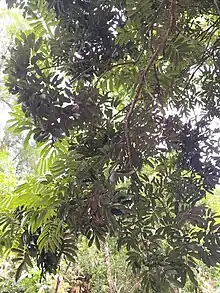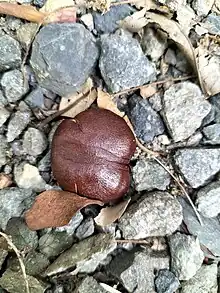| Castanospora | |
|---|---|
 | |
| Foliage | |
 | |
| Fruit | |
| Scientific classification | |
| Kingdom: | Plantae |
| Clade: | Tracheophytes |
| Clade: | Angiosperms |
| Clade: | Eudicots |
| Clade: | Rosids |
| Order: | Sapindales |
| Family: | Sapindaceae |
| Tribe: | Cupanieae |
| Genus: | Castanospora F. Muell |
| Species: | C. alphandii |
| Binomial name | |
| Castanospora alphandii (F.Muell.) F.Muell.[1] | |
Castanospora is a monotypic genus of trees, constituting part of the plant family Sapindaceae. The sole species Castanospora alphandii, commonly known as brown tamarind, grows naturally in the Australian rainforests of north-eastern New South Wales and eastern Queensland as far north as the Wet Tropics rainforests of north-eastern Queensland.[1][2][3][4]
Brown tamarind is known in horticulture, though it is only distantly related to the true tamarind.
References
- 1 2 "Castanospora (F.Muell.) F.Muell". Australian Plant Name Index (APNI), IBIS database. Centre for Plant Biodiversity Research, Australian Government, Canberra. Retrieved 5 December 2013.
- ↑ F.A.Zich; B.P.M.Hyland; T.Whiffen; R.A.Kerrigan (2020). "Castanospora alphandii". Australian Tropical Rainforest Plants Edition 8 (RFK8). Centre for Australian National Biodiversity Research (CANBR), Australian Government. Retrieved 19 June 2021.
- ↑ Harden, G. J. "Genus Castanospora". PlantNET - New South Wales Flora Online. Royal Botanic Gardens & Domain Trust, Sydney Australia. Retrieved 5 December 2013.
- ↑ Harden, G. J. "Castanospora alphandii (F.Muell.) F.Muell". PlantNET - New South Wales Flora Online. Royal Botanic Gardens & Domain Trust, Sydney Australia. Retrieved 5 December 2013.
External links
- "Castanospora F.Muell". Atlas of Living Australia.
This article is issued from Wikipedia. The text is licensed under Creative Commons - Attribution - Sharealike. Additional terms may apply for the media files.